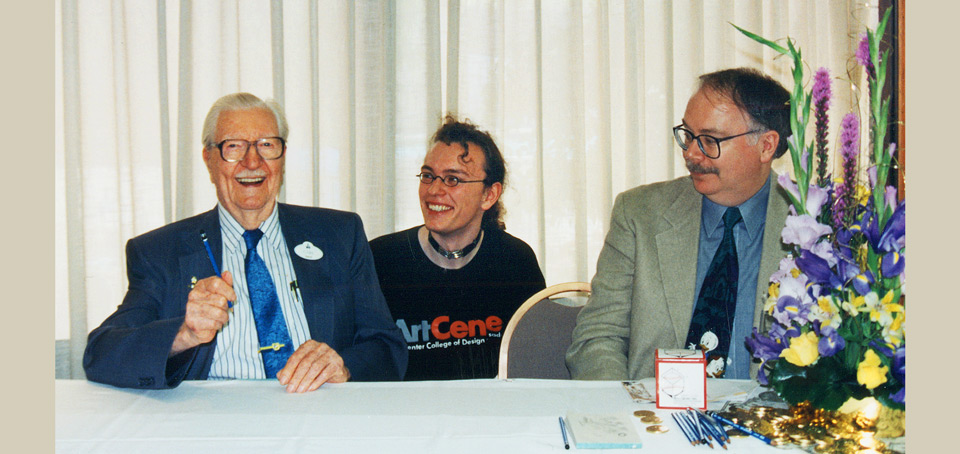DER DONALDIST
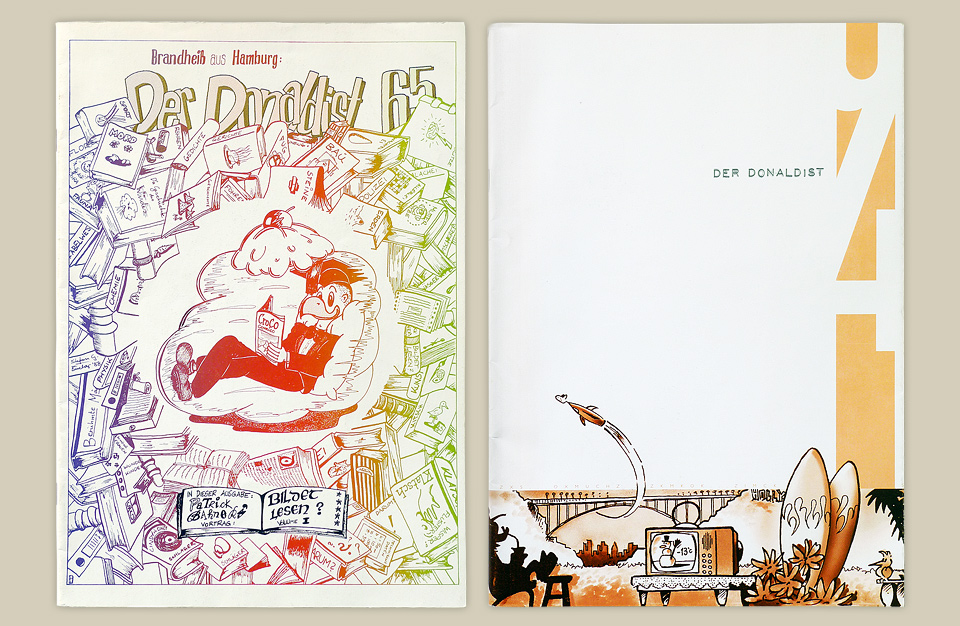
What “The Lancet” is to medicine, “Der Donaldist” is to donaldism. What is donaldism?It is the scientific study of the universe occupied by Donald Duck and his family—Daisy, his nephews, Scrooge McDuck, the lot. We’re not talking about collecting comic books.
The donaldists are a group of writers, philosophers and scientists of every stripe (professors, applied physicists, journalists and judges among them) that have spent the last 32 years analyzing the available source material—the canonical work of Carl Barks—to formulate theories about the laws of physics and rules of society in Duckburgh. “Der Donaldist” is the scientific journal that publishes their findings.
Over the years, donaldists have explained the scatter-shot nature of entropy in the duck universe, dealt with the phenomenon known as Veronkelung (literally uncle-ing—meaning that there are only aunts and uncles, never parents), and they explained how ducks can have teeth when they’re happy or angry. (As it turns out, their teeth are composed of erectile tissue that only pops up in emotionally heightened states like great joy or anger.)
Back in 1977 these scientists, led by out-of-work meteorology professor Hans von Storch, formed the Deutsche Organisation der Nichtkommerziellen Anhänger des Lauteren Donaldismus—the German Organization of Non-Commercial Followers of True Donaldism—or D.O.N.A.L.D. I’m sure you’ll be shocked—shocked—to learn that I was once one of them.
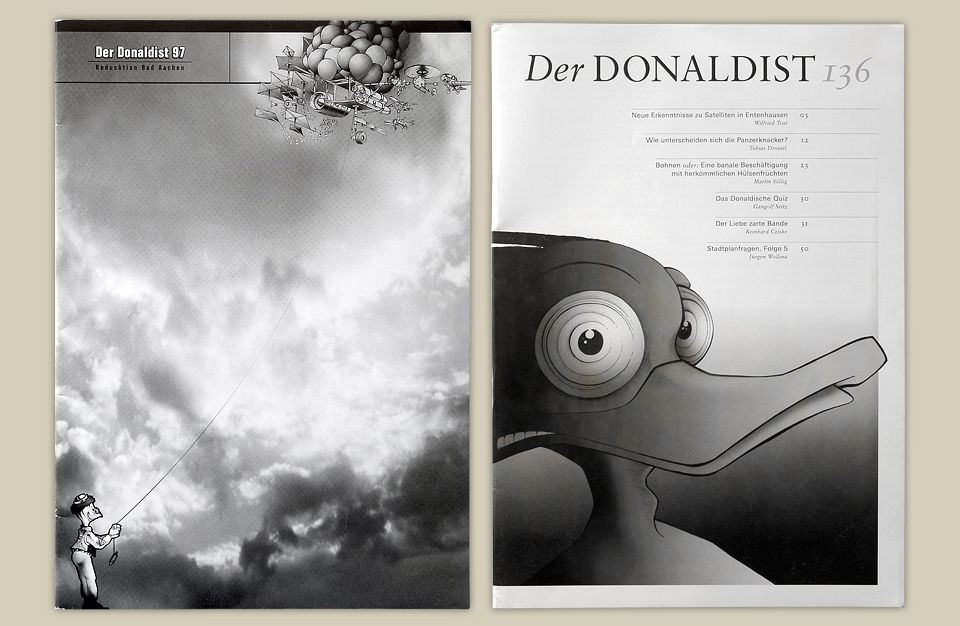
Issues 97 (October 1996) and 136 (December 2009)
The donaldists saved my life. I was a deeply unpopular kid growing up. I wasn’t into the stuff a regular German kid was supposed to be into. I was a big, fat geek. Which doesn’t sound so bad now, what with the geek renaissance, but this was many years before the internet. Being a geek still got you beaten up at school pretty frequently. “Conform or suffer” was the rule. I tried conforming, but everybody could see that it was an act. So I took my licks, and got deeper into drawing and reading and sci-fi and Disney comics. Which were huge in Germany, in part because of smart translations by Dr. Erika Fuchs, who packed the originally straightforward dialogue with allusions to classical literature and popular culture. It’s not something you could have gotten away with on the whole Marvel/DC superhero thing. Maybe that’s why it wasn’t a big presence over there until all the movies came out.
Around age 9 or 10 I had started writing to artists I liked to ask them for drawings, and got many wonderful responses. I knew that Walt Disney hadn’t drawn any of the comics appearing under his name, but if nothing else I still wanted to track down his autograph. I had read the name of his daughter Sharon Mae Disney-Lund in an article, and thought I could find out her address. My dad volunteered at the Wilhelm-Busch-Museum in Hannover (now the German Museum of Illustration and Critical Graphics), and his contacts there helped me get in touch with various publishers, but all those leads came up empty.
At that time I was already in touch with the German office of Walt Disney Productions, where I would send samples of obviously unlicensed Disney characters. Not because I was born with an unusually deep appreciation of copyright law, but because the drawings were sloppy. Even then I found that offensive. If you’re gonna rip off licensed characters, at least draw them beautifully.
The point is, I was hunting for that Disney autograph. One night my folks called me into the living room. They were watching a late night talk show. “Check out this guy!” they said. “He’s as much into Donald as you are.” That man was meterologist Dr. Hans von Storch, founder of the D.O.N.A.L.D. He was utterly deadpan and more than a little bit odd. I wrote to him immediately. Dr. von Storch (his actual name) passed on my letter, and a few weeks later I received a note from Dr. Gangolf Seitz, then the president of the organization, inviting me to apply for membership. He passed me on to Elke Imberger, who was in charge of the BKA—Befragen der Kandidaten im Aufnahmeverfahren—questioning of candidates in the application process. A large part of the donaldistic life was given over to parodying German officiousness. BKA is also the abbreviation of the Bundeskriminalamt—the German FBI.
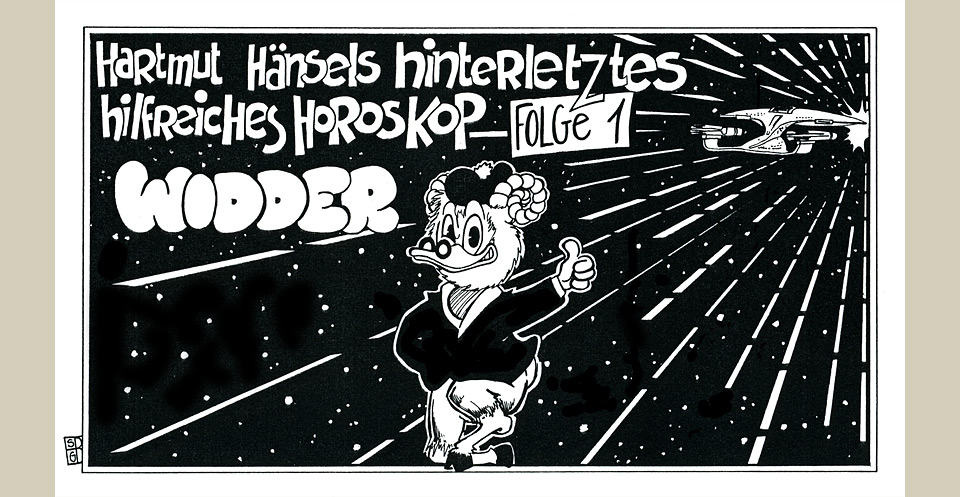
A title design for Hartmut Hänsel’s donaldistic horoscope. More about Hartmut later.
The application process consisted of signing a postcard bearing a preprinted statement of donaldistic values, and mailing it back to Elke. I failed. The real test was where you placed the stamp. Being proper, I stuck my stamp on the space designated by the pre-printed Donald stamp—which is to say on top of the duck. A true donaldist, I learned, would have placed the postage to the side of the Donald stamp.
I didn’t realize that it was all in good fun. When Elke pointed out my error I was truly panicked. These were my people—clearly—and I’d blown it with them before I’d even met any of them in person. And this was all happening by way of post. In longhand. Those were long days of waiting to see if I’d get a second chance.
Elke and I hit it off immediately, and became fast friends, exchanging long letters weekly. It was only years later that I recognized this for the massive act of kindness it was. I was 12 by then, and Elke was working on her doctorate in history. And still she took the time to write me long, funny letters—and she put up with my reports in return. Anything I know about writing like a person I first learned from her.
As time went on, I started corresponding with other donaldists, too—scientists, journalists, illustrators, there was a judge—and they all responded. They were my proto-internet. Today you can just google anything you’re into, and find like minds all around the world. In 1985 I just got unbelievably lucky. Among the people I met was my friend Chuck Munson, a rare American donaldist and a true mensch, who later helped me set up my life here in California. Funny how things work out.
I should also point out how fortunate I was that my parents supported all this craziness without hesitation. For years my dad would drive all over the country with me, attending the various donaldistic events where he was invariably greeted as my uncle. (No parents in Disney comics, remember—only aunts and uncles, nieces and nephews.) My folks aren’t weird, really, but they proved to be weird-compatible.
Right at the start of my friendship with Elke Imberger, she asked if she could publish one of my drawings in the next issue of Der Donaldist. Beyond her BKA duties she was also in charge of the reader mail section. It was the first time I’d seen one of my drawings published and I was hooked the second I flipped to page 40 of issue 54. “Bottom left! That’s me! That one’s mine! How do I get to do that again?” Incidentally, I made that drawing of golfing Donald based on instructions from the 1983 book “Mickey’s Drawing Class: Featuring Donald; With Step by Step Method Developed by Lee J. Ames.” You can still find used copies on Amazon. It really worked for me, as you can see.
Most everybody I was writing to in those days published their writing in the magazine, and they were all happy to let me draw the titles for their articles. Over the next few years I did dozens of illustrations, learning about design and lettering and printing as I went along.
It took me nine issues to land the cover. Large parts of issue 65 were given over to Part 1 of the article “Does Reading Educate?” by Patrick Bahners, who went on to become the features editor of the Frankfurter Allgemeine Zeitung. The illustration he asked for is of his birdified avatar encased in Jello—an allusion to a Barks comic where contestants in a game show are thus punished for incorrect answers—and surrounded by heaps of books with funny titles. It’s not hard to draw a line from this cover to the 344 Things poster, for example, or to You Deserve A Medal or to the Echo Park Time Travel Mart. In print, a cascade of small jokes is always better than one big gag.
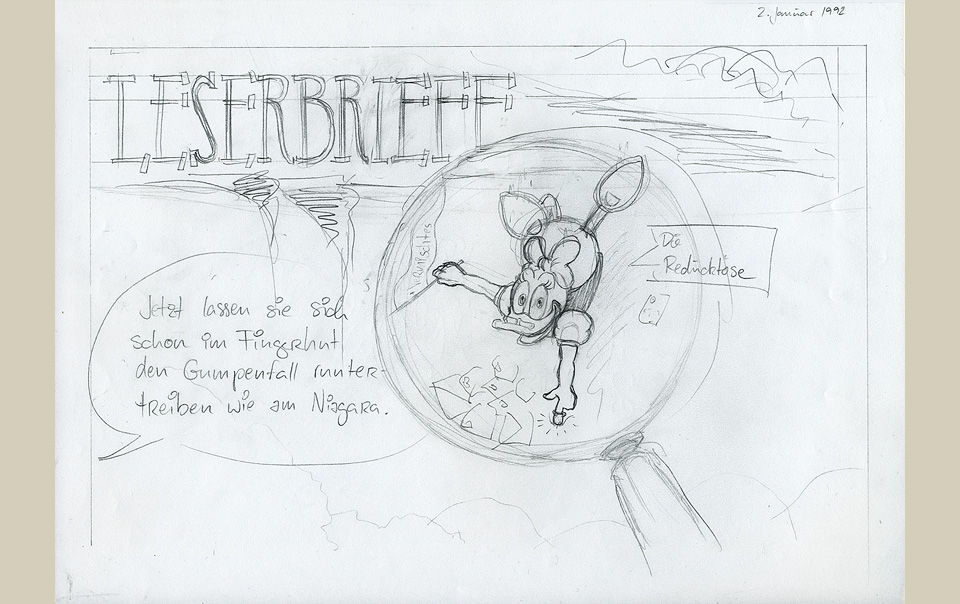
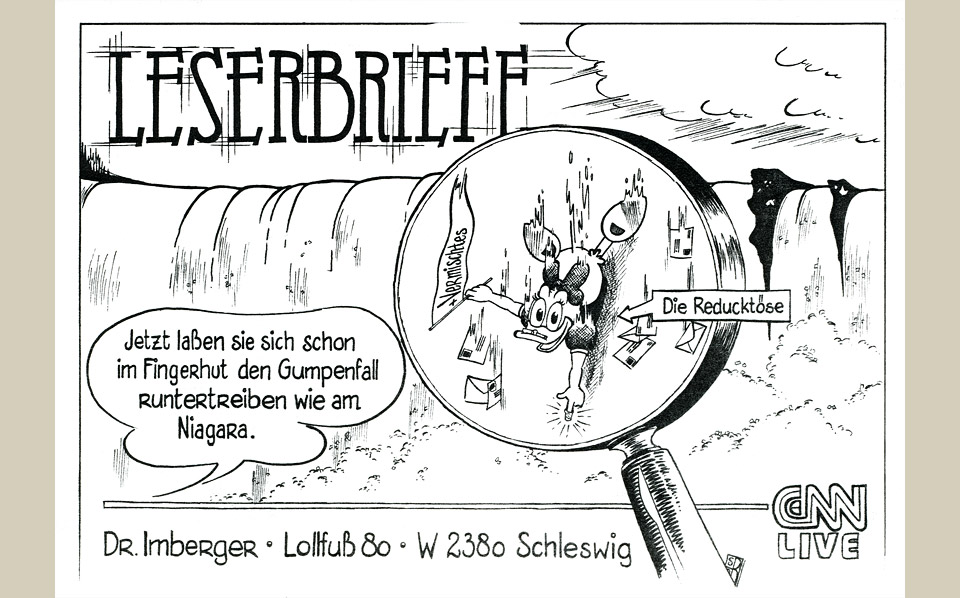
One of the many “Readers Letters” column titles for Elke Imberger.
Following the national D.O.N.A.L.D. congress in 1989, I had a falling out with a few of my best friends in the organization, and decided to find something else to do with my spare time. That’s how I first got into advertising. But over the years I continued dipping my foot into donaldistic waters, due mainly to the kind efforts of my friend Hartmut Hänsel. Hartmut is a physicist who develops advanced halogen lightbulbs for Philips. He also edits the occasional issue of Der Donaldist, and lures me with offers of designing the cover. Hartmut also coined my German nickname “StGB”—an acronym I share with the Strafgesetzbuch, the German penal code.
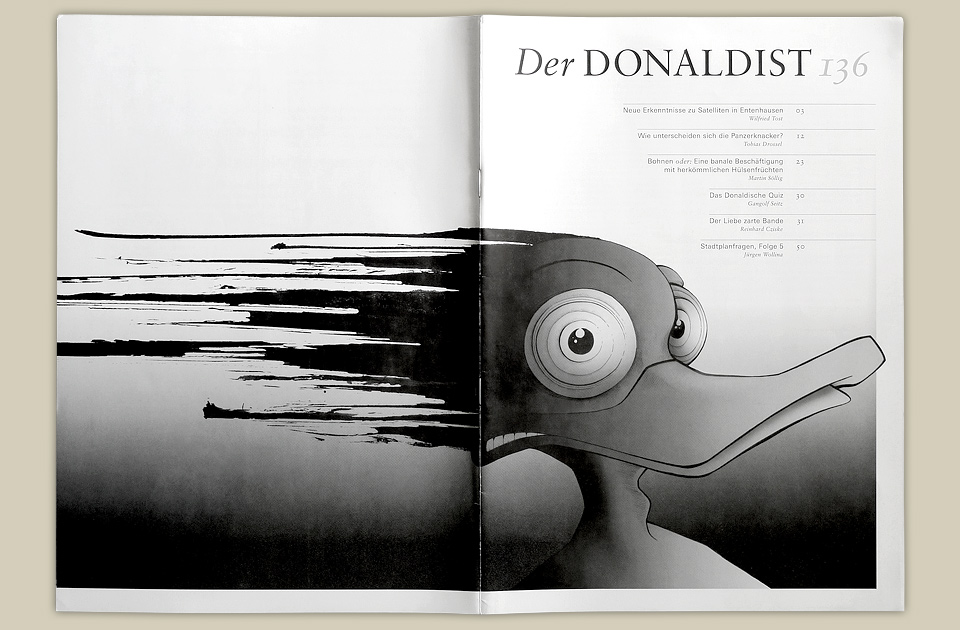
By 2009 the duck had been enhanced with Daily Monster DNA.
For him I designed the covers for DD94, DD97, and DD136, which marked my 25th year as a donaldist. I remember spending weeks on the DD94 cover during my time at Art Center. Most covers for the magazine looked like a Disney cartoon had been assaulted by an issue of ZAP Comix. I wanted to bring clean design to the table. This was the holiday cover, so the whole idea was to show Christmas in California, while cramming the illustration with allusions to Christmas stories drawn by Carl Barks. Take my word for it: This cover has high geek density. I made the title on a label maker, by the way, and assembled the whole thing as a two-color job in Adobe Photoshop 3.0, the first version with layers.
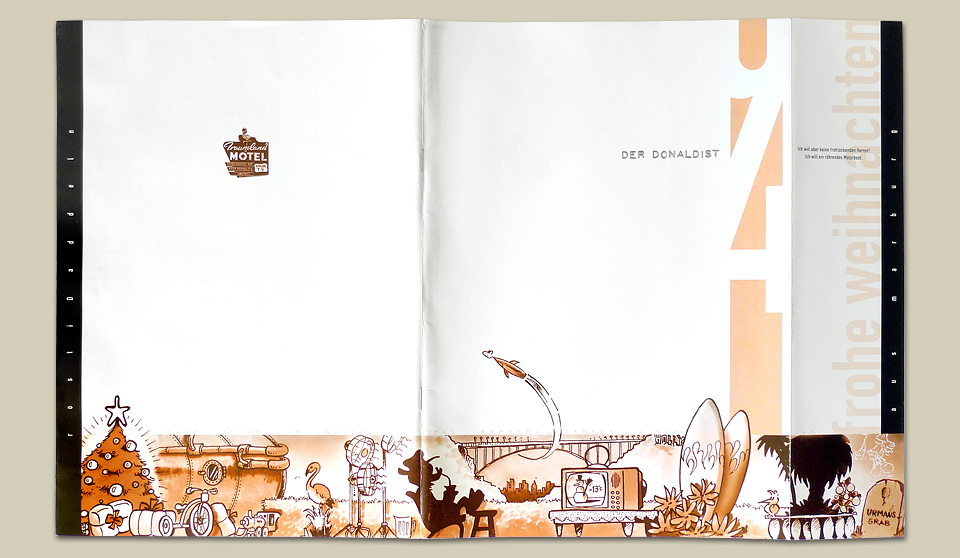
The cover was supposed to fold over into a flap right at the edge of the big 94, but the printer screwed that up. Still looks OK, but I remember being distraught. On the inside of the flap lived the table of contents, so you could have access to it while reading the magazine. I revived that idea for All Access nine years later.
Just after finishing that cover in the summer of 1995 I got to meet Carl Barks at a signing in Anaheim, California, and I gave him a copy. One of his assistants was kind enough to take a photo of us together. You don’t see me smile that big very often.
